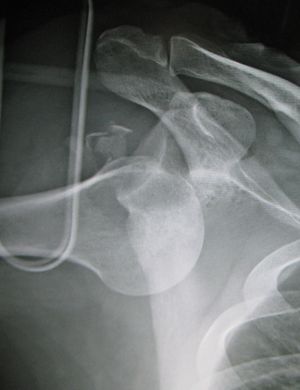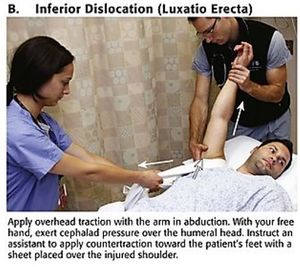We need you! Join our contributor community and become a WikEM editor through our open and transparent promotion process.
Inferior shoulder dislocation
From WikEM
Contents
Background
- Also known as "Luxatio Erecta" due to the presentation of arm held in full abduction
- Accounts for ~0.5% of all shoulder dislocations[1]
- Mechanism: typically hyperabduction force which levers the humeral neck against the acromion
- Can also be secondary to high-energy force applied directly to shoulder from above[2]
- Frequently associated with significant soft tissue injury or fracture[1]
- Axillary nerve palsy in 60% (usually rapidly resolves after reduction[2]
- Humerus fracture in 37%
- Rotator cuff tear in 12%
Clinical Features
- Patient presents with humerus fully abducted with hand on or behind the head
- Humeral head can be palpated on axilla or lateral chest wall[1]
Differential Diagnosis
Shoulder and Upper Arm Diagnoses
Traumatic/Acute:
- Shoulder Dislocation
- Anterior shoulder dislocation
- Posterior shoulder dislocation
- Inferior shoulder dislocation
- Clavicle fracture
- Humerus fracture
- Scapula fracture
- Acromioclavicular injury
- Glenohumeral instability
- Rotator cuff tear
- Biceps tendon rupture
- Triceps tendon rupture
- Septic joint
Nontraumatic/Chronic:
- Rotator cuff tear
- Impingement syndrome
- Calcific tendinitis
- Adhesive capsulitis
- Biceps tendinitis
- Subacromial bursitis
Refered pain & non-orthopedic causes:
- Referred pain from
- Neck
- Diaphragm (e.g. gallbladder disease)
- Brachial plexus injury
- Axillary artery thrombosis
- Thoracic outlet syndrome
- Subclavian steal syndrome
- Pancoast tumor
- Myocardial infarction
- Pneumonia
- Pulmonary embolism
Evaluation
- Plain film X-ray in at least 2 views
Management
- Closed reduction
- Consider Procedural sedation
- Apply traction in upward and outward direction (along same axis as humerus)
- Simultaneously apply counter-traction with sheet on upper shoulder and chest wall[3]
- Alternatively, use the Two step reduction- convert inferior dislocation into anterior, then reduce anterior dislocation
- Apply sling with arm in adduction and internal rotation.
- Post-reduction X-ray
- Failure of closed reduction may occur secondary to "buttonholing" of humeral through defect in glenohumeral capsule → consult ortho for open reduction[6]
Contraindications to closed reduction[1]
- Humeral neck or shaft fracture
- Suspected major vascular injury
- In these cases, open reduction is indicated
Disposition
- Discharge after successful reduction
- Ortho follow-up
See Also
References
- ↑ 1.0 1.1 1.2 1.3 Imerci A, Gölcük Y, Uğur SG, et al. Inferior glenohumeral dislocation (luxatio erecta humeri): report of six cases and review of the literature. Ulus Travma Acil Cerrahi Derg. 2013 Jan;19(1):41-4.
- ↑ 2.0 2.1 Grate I Jr. Luxatio erecta: a rarely seen, but often missed shoulder dislocation. Am J Emerg Med. 2000 May;18(3):317-21.
- ↑ Amanda E. Horn and Jacob W. Ufberg. Management of Common Dislocations. http://clinicalgate.com/management-of-common-dislocations/
- ↑ Davenport M. Procedures for orthopedic emergencies. In: Bond M, ed. Orthopedic Emergencies: Expert Management for the Emergency Physician. Cambridge: Cambridge University Press; October 31, 2013.
- ↑ Horn A. Management of Common Dislocations. In: Roberts and Hedges' Clinical Procedures in Emergency Medicine. 6th ed. Philadelphia, PA: Elsevier; 2014.
- ↑ Lam AC, Shih RD. Luxatio Erecta Complicated By Anterior Shoulder Dislocation During Reduction. Western Journal of Emergency Medicine. 2010;11(1):28-30.
Authors
Michael Holtz, Ross Donaldson, Ted Fan, Kevin Lu, Neil Young, Claire, Daniel Ostermayer


